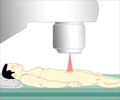Researchers at UT Health Science Center have come out with an update to their prostate cancer risk calculator that will help men and their doctors better understand the risk of the disease.

The free calculator on the Health Science Center website takes just minutes to use and gives a man more information about his risk for both low-grade prostate cancer, which may never require treatment, and high-grade prostate cancer. It provides an "emoji" graphic readout that puts the numeric percentages into a visual perspective. Significantly, it also gives the possibility in numbers (and emojis) that he may have no prostate cancer at all. "What is important are the three numbers," Dr. Thompson said. "For doctors, it makes for a more challenging conversation with the patient. For the patient, it gives him better information so he can decide how he wants to move forward." The primary purpose of assessing prostate cancer risk is detection of high-grade, high risk cancers. "The prostate cancers you want to find are the high-grade cancers," Dr. Thompson said, "because then we can take action to prolong and even save a man's life." "On the other hand, in some men, a prostate biopsy will far more commonly find a low-grade cancer. These cancers have such a low risk that many men who take the time to fully understand the options, decide to simply monitor them", says Dr. Thompson. "For many men who have been diagnosed with these low-risk cancers, they wish they'd known about that before they had a prostate biopsy; many, in retrospect wish they'd not had a biopsy in the first place. This new risk calculator helps them understand that risk in advance."
The risk calculator is based on data from the 18,882-man National Cancer Institute's Prostate Cancer Prevention Trial (PCPT), a national multi-site study of which Dr. Thompson was original principal investigator. The first risk calculator was made available in 2006, but Dr. Thompson said as screening and treatment affects more and more of the population, it changes the risk factors that affect the calculations. The CTRC scientific team has continued to update the calculator since 2006. "The new calculator should provide a more accurate prediction of the outcome that a man would expect on biopsy because it incorporates a substantially larger amount of patient data than the original calculator," said Donna Ankerst, Ph.D., research professor of urology at the Health Science Center and professor of mathematics at the Technical University in Munich, who helped develop the calculator. "It also uses an advanced statistical model to distinguish the prediction of low-grade and high-grade disease." Along with building on the knowledge that continues to come from data in the Prostate Cancer Prevention Trial, the new calculator also incorporates data from a separate study conducted by Dr. Thompson. That study, called San Antonio Center of Biomarkers Of Risk for Prostate Cancer (SABOR) gave the researchers a new biomarker called percent-free PSA. "Step by step, we are assembling the tools to help men work with their doctors to make better-informed decisions about their treatment," Dr. Thompson said. "And, as steps go, this is a big one."
Source-Eurekalert














